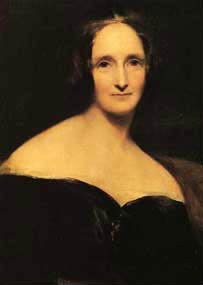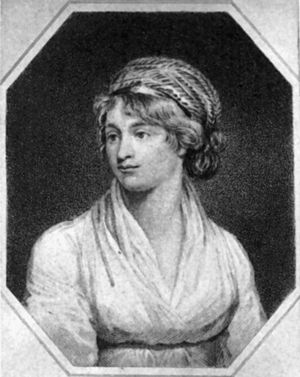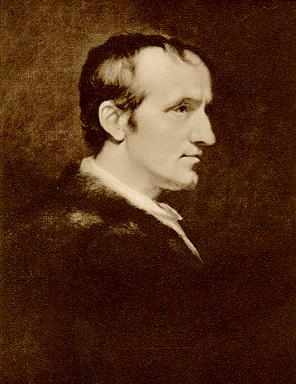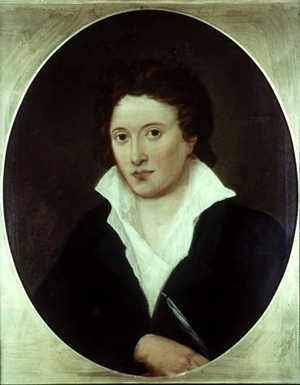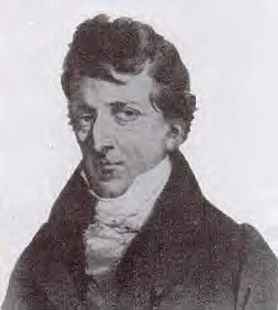Mary Shelley
Mary Wollstonecraft Shelley, née Godwin (30 August 1797 – 1 February 1851) was an English author.
Biography
Family
Mary Wollstonecraft Shelley was the daughter of the feminist philosopher Mary Wollstonecraft and the political philosopher William Godwin. Mary Wollstonecraft’s first child, Fanny, the daughter of Gilbert Imlay, was born in 1794 and adopted by William Godwin.
Though Wollstonecraft and Godwin were theoretically against the institution of marriage, they married before the birth of their common child, Mary. Eleven days after the birth, the mother died of puerperal fever. Godwin was over forty at that time and had financial problems. His housekeeper, Louisa Jones, looked after the two girls. One year after the death of his wife, Godwin started to court the writer Harriet Lee, but was not successful.
In 1801, he married Mary Jane Vial, who called herself Clairmont. She added two children to the family: Charles and Jane, who were the same age as Godwin’s daughter Mary. Two years later, the couple had a son, William.
Education
It was difficult to procure standardized education for the five children, especially because the economic situation was still bad. Mary’s school education was not continuous. She learnt more from her father, his library and his visitors than she learnt from school.
The poet Samuel Coleridge held readings and speeches for the family. The chemist Humphrey Davy was a frequent guest in Godwin’s house and so was the Vegetarian John Frank Newton. Lots of new ideas were discussed between family and friends, and we know from Mary’s notes that she was often present in those discussions.
From 1812 until 1814, young Mary stayed in Scotland with the Baxter family.
Leaving home
During her stay in Scotland, Mary came home for a holiday and met an admirer of her father, Percy Bysshe Shelley, and his 17-year-old wife Harriet. In March 1814, Mary returned to stay at home. In the meantime, Shelley had become a frequent guest. He and Mary fell in love with each other and three months after her return from Scotland, they decided to leave the country together.
Mary’s half-sister Jane, who now called herself Claire, witnessed this process and eloped together with the couple. On the way, Shelley wrote a letter to his wife, asking her to join them all in Switzerland. Harriet was not willing to do that. She stayed in England, with their daughter Ianthe and pregnant again.
The young couple wrote about the journey to the continent a kind of diary, which was to be published shortly afterwards. Traces of many impressions can be found in the Frankenstein novel, like for example the mountains of Switzerland and the Frankenstein castle.
Six weeks later, the travellers were back in London. There are some hints that Claire/ Jane was pregnant. In February 1815, Mary gave birth to a daughter. The circumstances of living were very poor and Mary was desolate because when she needed help, Percy went out with Claire. In March, baby Clara died. Mary was suffering from nightmares. Percy, instead of taking care of Mary, asked his friend Thomas Jefferson Hogg to take over this part. He suggested a ménage à trois. Mary estimated Hogg a lot, but did not really consent.
In August 1815, the couple moved to Bishopsgate, where they had a better life than before. In January 1816, Mary’s and Percy’s son William was born.
Claire was fascinated from afar by George Gordon Lord Byron and did everything to meet him. Byron was planning a trip to Switzerland and Claire was able to convince her friends to follow the famous poet.
The birth of "Frankenstein"
In April 1816, Byron travelled to Switzerland with his young assistant, Dr. John Polidori. Byron rented the Villa Diodati at Lake Geneva. In the same month, Mary followed with baby Claire and Percy, and rented the modest Maison Chapuis, only five minutes' walk away from Byron’s mansion.
On a stormy evening in June 1816, the young people (Claire excluded) started a competition. Almost all participants left notes about this evening. The idea which came up was that a ghost story should be written. Percy Shelley began a sketch but did not continue. Byron wrote “The Vampyre”, which remained a fragment, Polidori created a novel also called “The Vampyre”, and Mary Godwin had the first ideas for "Frankenstein".
There are many mysteries about the background of Frankenstein. The most puzzling question is why the author called the monster’s little victim 'William', the name of her father and that of her son.
Back in England
By August 1816, the young couple and Claire returned to England. In October, Mary’s Half-Sister Fanny took an overdose of Laudanum. In the beginning of December, the body of Percy’s wife Harriet was found in Hyde Park. In the end of December, Mary and Percy married in church.
In January 1817, Claire gave birth to Lord Byron’s daughter Allegra.
In March 1817, the couple without Claire moved to Albion House in Marlow, where Mary finished the novel “Frankenstein” in May 1817. She mentions in her diary, that the absence of Claire was good for her. In September, her daughter Clara Everina was born. The family stayed happily in Marlowe until March 1818.
Crisis in Italy
Percy Shelley was in a bad physical condition. His doctors recommended a cure in a warm climate. He thought about travelling to Italy again and was in this point unanimous with Claire who wanted to meet Byron. So three adults and three children travelled first to Naples, then to Florence and to Pisa.
The climate and the southern diseases were harmful for the children. Clara Everina fell sick and due to a lack of organisation in the household was not brought to the doctor in time. The girl died in September 1818. Less than a year later, in June 1819, Mary’s son William died. Mary was 22 years old at that time and had lost three children.
In November 1819, Mary’s son Percy Florence was born, the only child that would survive. In 1820, the family moved from Florence to Pisa, where they stayed until 1822. In 1820, Percy Shelley met the Italian lady Emilia Viviani and wrote love poems to her. When she married, the romance ended.
The Shelleys met an English couple, Edward and Jane Williams. Together, they rented Villa Magni, a humid building at the gulf of Lerici, in April 1822. Percy Shelley fell in love with Jane Williams and sang love songs for her. The atmosphere in the house was strained.
The two men had a common affection: they liked sailing. Percy Shelley had been sailing with Lord Byron in Switzerland and was enthusiastic, though he could not swim. He bought a boat and called it “Ariel”. Together with his companion Edward, he sailed to Livorno. They sank on the way back to Lerici. The bodies were found many days later.
The situation for Mary Shelley was very hard. At the age of 25, she was a penniless widow.
Later literary career
On her return to England in August 1823, she found that her father had commissioned a new edition of Frankenstein because a play based on it was being produced. The play and the new edition were a great success and the sales gave her some financial independence. She also set out to publish Percy Shelley's posthumous poems and negotiated with his father for an annuity for herself and her son. In this she was partially successful, but it was a condition of the annuity that she stop the sales of the poems. She built on the success of Frankenstein to write other novels, none of which is now remembered in the same way. She continued to regard herself as the guardian of her late husband's reputation and eventually, in 1839, was able to bring out a complete edition of his work in three volumes, with her own notes.
New relationships
Many interesting men courted her, but without success. The first was the adventurer Edward John Trelawny, a friend of the family. In 1824, the American author Washington Irving was deeply impressed bay her. So was the American actor and playwright John Howard Payne one year later. When Mary was in Paris in 1828, she met Prosper Mérimée in Paris, but was not inclined to give in to him.
In 1833, Mary realized that she was fascinated by a young man named Aubrey Beauclerk, Ex-Major and politician. It is not known if there was a kind of relationship between the two of them or if it was only Mary’s admiration. Very soon, she understood that she had no chance because Beauclerk married another woman. When his wife died in 1840, new hopes arose, but were not fulfilled.
In 1842, she visited Claire, who was living in Paris at that time. A young man, Ferdinando Luigi Gatteschi, member of the insurgent group of the “Carbonari”, told Mary about the fight for freedom in Italy. She was eager to support him. Unfortunately, Gatteschi used her inclination to blackmail her. In 1845, he claimed that she had promised to marry him. He wrote that he would publish her letters if he did not receive a certain sum. With the help of her son’s friend, the problem could be solved.
Mary’s son Percy Florence married in 1847. His wife Jane took good care of her mother-in-law, who was constantly becoming weaker because of a brain tumour. Mary Shelley died in London in 1851.
Influences
Mary Shelley’s work was influenced by many different factors. The misery in most of her books is certainly based on the many tragic deaths she had experienced in her family.
Literature
Both parents of Mary Shelley were philosophers and authors. Mary’s stepsister Claire complained that writing was so normal in this family that she felt awkward when not writing. Theire was a huge library in the house and many friends of the family were authors as well. Mary reports about one evening that impressed her a lot, when Samuel Coleridge read his poem “The Ancient Mariner” to the family.
Those dark stories impressed Mary very much. During the gloomy evenings in Switzerland in 1816, Byron, Shelley and the others read a collection of German ghost stories. Byron’s friend, “Monk” Matthew G. Lewis, author of gothic novels, visited the young people and spoke to them about ghosts. Percy Shelley had a vivid nightmare which might have been caused not only by these stories, but also by narcotics.
Science
The discussions about scientific experiments had a big impact on many of Mary Shelley’s novels, especially on “Frankenstein”. Her father, William Godwin, was discussing questions of electricity together with his friends, the chemist Humphrey Davy and the surgeon Anthony Carlisle, who had discovered the phenomenon of electrolysis. In 1803, Godwin visited a performance presented by Giovanni Aldini, professor of physics in Bologna and nephew of Luigi Galvani. In his performances, Aldini stimulated bodies of animals and men with the help of electricity. The convulsions of the eyes and the movements of the body impressed the audience immensely. People discussed if resuscitation through electricity was possible and if electricity was the origin of everything. They thought that lightning might generate life.
We know from her records, that Mary followed those discussions in her father’s house. Many years later, Percy Shelley and Lord Byron discussed about experiments and their consequences. Erasmus Darwin was said to have vitalised a piece of vermicelli in a glass. Mary’s comments show that she doubted that this story was true, but it was the initial point of longish philosophical discussions.
Narcotics
It is not known whether Mary Shelley ever took narcotics, but around her, the use of drugs was very common. Doctors prescribed laudanum, opium dissolved in alcohol, for all sorts of diseases and also just for relaxing, even for children. Suicide by an overdose of laudanum was quite common. Percy Shelley used a lot of laudanum together with wine, as did Lord Byron. Fanny Imlay, Mary’s half-sister, killed herself with an overdose.
Hallucinations were common. The world of monsters and ghosts crystallized in nightmares. Even if Mary may not have taken laudanum herself, she experienced the effect on others and described it. She also mentioned it in her novels “Frankenstein” and “The Last Man”.
Vegetarianism
One of William Godwin’s guests was John Frank Newton, main ideologist of the vegetarians. Mary heard of these ideas when she was a child and she also turned to vegetarianism, because Percy Shelley, following Newton’s ideas, was a strict vegetarian. The children were also afflicted. It demands a lot of knowledge to bring up children without giving them meat. In the beginning of Vegetarianism, this knowledge was not yet existent.
Byron was also a strict Vegetarian. Percy Shelley wrote “Vindication of Natural Diet” in 1813. He maintained that Vegetarians are peaceful beings. In his wife’s novel “Frankenstein, the monster only eats berries and roots, but is everything but peaceful.
Anti-authoritarian education
The theories of anti-authoritarian education came up with enlightenment. J.J. Rousseau was still moderate in his thoughts about education, recorded in “Emile”. Popular interpretation interpreted the ideas in a way that children should have their own will completely.
Marianne and Leigh Hunt were friends of Byron and the Shelleys. Their nine children terrorized Lord Byron and later also Mary Shelley.
Critical ideas about education also were reflected in her books.
Atheism
Percy Shelley expressed his atheism in “The Necessity of Atheism” and in the vast footnotes to the poem “Queen Mab”. Mary Shelley did not declare if she believed in God or not. Some of those who interpreted “Frankenstein” claimed that the creation of the monster was an act of revolt against God. The creator was punished severely, so that Mary Shelley may have thought of the moral message not to revolt against God.
Free love
The basic work about free love was written by Charles Fourier: “Le Nouveau Monde Amoureux”. It was not published until 1964. The book dealt with economic and emotional as well as sexual suppression and the hypocrisy of marriage.
Percy Shelley was a follower of those ideas. He had already tried in vain to establish a ménage à trios with his first wife Harriet and his friend Thomas Jefferson Hogg. He suggested the same to Mary and encouraged Hogg to court her. She tried to retard a decision, did not want to snub Hogg, whom she really seemed to like. Through all their married life, Percy courted other women. Amongst them were Claire, some Italian ladies and the last was Jane Williams. For Emilia Viviani, he wrote the poem “Epipsychidion” in which he confessed:
“I never was attached to that great sect Whose doctrine is, that each one should select Out of the crowd a mistress or a friend, And all the rest, though fair and wise, commend To cold oblivion …”
Free love in this differs from gold and clay, That to divide is not to take away.”
(“Free” was replaced by “true” before publication.)
Mary Shelley suffered, but never protested. She admired her husband and supported his ideals as far as she could.
